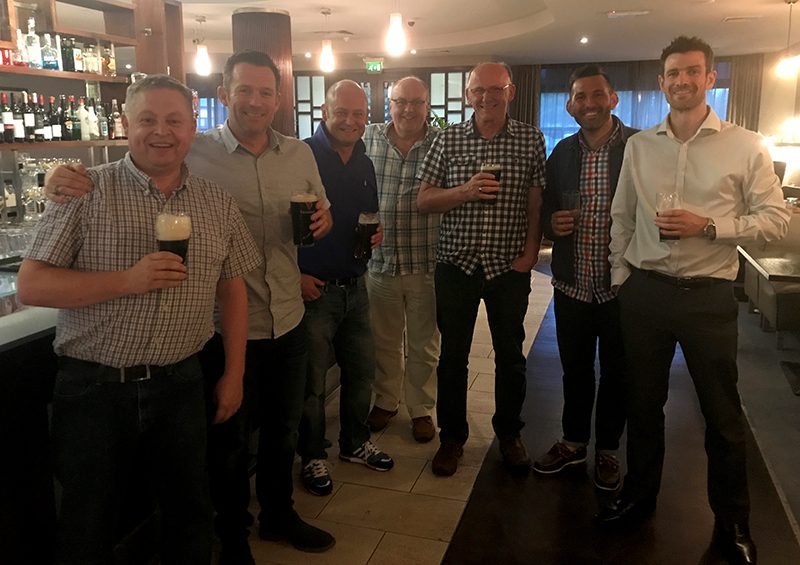A recent order for SP load cells proved the value of simplicity, says Mr. Loadlink, who also reflects on U.S. planning meetings and wishes an old friend a happy retirement.
I rarely get through a blog without referencing the importance of planning (this one is no exception!). As a business, SP is a meticulous planner; we break yearly plans into quarterly plans, into monthly plans, and so on. Everyone has a set of responsibilities and individuals know their roles as they relate to the wider mechanics of the company. If something happens—good or bad, expected or unexpected—you can bet your bottom dollar there’s a plan for it.
Sound complicated? Wrong
The purpose of these plans is to simplify the way we do business with an end goal of making it easy for customers to work with us. I’ll elaborate but first let me share a short story to demonstrate what simplicity feels like as a customer:
Zoe Silk, sales and hire here at SP, took a telephone enquiry for some load cells from a potential new customer recently. It was a Thursday. Within 30 minutes she had delivered a quote and later the same day followed up. The order was taken and shipped the following day prior to arrival onsite on Monday.
Upon taking delivery of the equipment, the customer told Zoe how impressed he was at the ease with which we processed the order and got the kit to him. He said he’d asked for several quotes but two of them arrived the day we shipped the load cells and the other still hadn’t arrived. The SP load cells could literally have been on a crane while another supplier was still assembling information to provide a quote. Think about whom he’ll call next time.
Sure, Zoe is a diligent professional, but all she did was follow a simple plan. Simple for her, simple for the customer. At no point in the process between taking the call to rigging the equipment below-the-hook was there a complexity to overcome. In that moment, Zoe was responsible for the company upholding its commitment to work to the shortest lead times in the sector, but she didn’t have to do anything out of the ordinary to deliver.
I’ve heard stories about companies adding layers of complexity, particularly when it comes to quoting new customers. Before an enquiry can be advanced in some instances, personnel are required to fill out long forms about the person on the end of the phone, before initiating an unnecessarily complicated process to gather the relevant information from different departments. This may well have been the case when Zoe beat three others to the punch.
Beauty isn’t skin-deep
Simplicity isn’t effective if it’s only a facade; it has to be in the DNA of a company. We share information and communicate with each other with the same clarity and simplicity that our customers experience. Facts are outlined clearly, not buried in lengthy emails that skate around the issue. If staff always follow a plan and aim to simplify their processes, that will filter into client engagement and order fulfillment. Try it.
Simplicity is intrinsic to a good plan. When we sit down for a quarterly planning meeting, we don’t arrive burdened with briefcases full of paperwork or calculations down to the last dime. It’s not a time to blind people with science or compete over who can work out turnover or profit down to the most decimal points. There’s no digital chart on the big screen with 15 different measurables fluctuating every minute with the stock exchange.
Instead the content is much simpler: how is this product performing? What problems are we experiencing with its supply chain? What did we do well? What did we do not so well? How can we do more of the good stuff to boost the next quarter? What isn’t working? What are our distributors telling us that we need to be aware of? Has anyone got any feedback from relevant markets they’d like to share?
This was very much the tone of our Q2 review when I visited the states earlier this month. Also on the agenda was finalising a restructure of the U.S. operation under Jeff Miller, the general manager of Straightpoint Inc., based at HQ in Camarillo, California.
Job titles and roles are another area of business that gets overly complicated by some people. The key consideration should be matching a person’s skills to a role where they will be best-suited and most likely to make a positive difference.
(As somewhat of an aside, I’d rather have somebody in a place where they can positively influence or disrupt a marketplace through development of their personal brand than restricted within the confines of a job description written for someone else. I think we’ve discussed square pegs and round holes before.)
Using a blueprint
One could probably define blueprints as successful plans, meaning there’s a place for them at any successful company.
Here in the UK, David Mullard, business development manager, and I have benefitted from a clear plan on how to develop business. It’s also allowed Mike Neal, product sales engineer, to improve our lead conversion on non-standard products. It made sense, therefore, to implement a similar strategy on the other side of the pond.
To that end, Wayne Wille has stepped into the role of national business development manager, and Aaron Orsak is now regional business development manager. The pair will take care of developing our distribution channels and meeting with dealers. John Molidor, as director of projects and market development, meanwhile, can focus more exclusively on engineered load cell projects and large-scale orders. Say the military want 250 load cells of a certain type, John will be well placed to advance…the enquiry, that is.
Since returning from the states I’ve been involved with product development. I can’t say too much about the innovations yet, but it’s relevant to this blog because of the extent to which we simplify the process through planning.
If you don’t already use a Gantt chart (named after creator Henry Gantt) to track a product development schedule, you might be overlooking important detail that will later impact the launch or production line. From the initial design concept to product unveiling and posting a video on YouTube, a good Gantt chart will cover it all.
This excerpt from Gantt’s 1919 book titled, ‘Organizing for Work’ resonates with me:
‘…it is so simple that it is readily understood by the workman and employer, and so comprehensive that one intelligent workman made the remark, ‘If we chart everything we are doing that way, anybody can run the shop.’ While we are hardly prepared to agree with this opinion, we are entirely satisfied that if the facts about business can be presented in a compact and comprehensive manner, it will be found possible to run any business much more effectively than has been the custom in the past.’
Hear, hear!
Stalwarts set sail
In closing, I want to pay tribute to two friends who recently announced their retirements—Fred Ashcroft, who has called time after 47 years in the weighing industry; and Geoff Holden, former chief executive of LEEA.

We celebrated the retirement of Fred Ashcroft (third from left) after a suitably hot curry! SP’s David Mullard (far left) and Mike Neal (to his left) joined us. Mike is also ex Weightronix.
I worked with Fred for a number of years at Weightronix and then employed him at Solent Scales when I owned that business. He has been selling load cells and weighing systems since 1970 and is a true legend of the sector. I was honoured to be among SP representatives at his retirement curry. Fred always did like it hot!

Here I am with Geoff Holden (third from right) and friends on what turned out to be one of my last pints with him as chief executive of LEEA.
On Geoff’s watch, membership in the association grew to 1,100 in 62 countries. He frequently travelled to all four corners of the world (I know that because our paths often crossed en route!) to represent the association and its members. Geoff always spoke about LEEA and the lifting industry with a passion that will be sorely missed.
More importantly, Geoff always seemed to be a trustworthy, salt of the earth bloke that I always looked forward to seeing at trade shows and events. He was constantly willing to share the benefit of his experience, yet equally forthcoming in giving younger professionals a chance to shine. I hope his retirement affords him the time to drop into the industry again, when we’ll be sure to find another bar to catch up and exchange battle stories.
I hear Geoff plans to spend a lot of time on his boat—I’ve heard many a tale about his sailing antics—and I wish him, and his wife, Linda, a long and happy retirement on and off the water.
As Rat says to Mole in ‘The Wind in the Willows’
‘Believe me, my young friend, there is nothing—absolutely nothing—half so much worth doing as simply messing about in boats. Simply messing about in boats—or with boats. In or out of ’em, it doesn’t matter. Nothing seems really to matter, that’s the charm of it. Whether you get away, or whether you don’t; whether you arrive at your destination or whether you reach somewhere else, or whether you never get anywhere at all, you’re always busy, and you never do anything in particular; and when you’ve done it there’s always something else to do, and you can do it if you like, but you’d much better not.’
Literally or otherwise, happy sailing, my friends.
Mr. Loadlink
